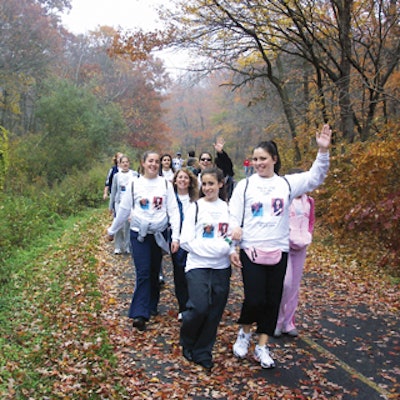When CancerCare manager of special events Kara Perrin and her Manhattan-based team were assigned to take over the nonprofit's previously sluggish lung cancer fund-raising walk in Massapequa, New York, this past fall, they faced a few different challenges: Their main goal was to increase attendance and revenue for the walk, which had attracted fewer than 50 participants in past years—mostly friends and family of committee members—while increasing awareness of the event within the local community. But the tougher challenge was coordinating their first Long Island-based program. "The biggest hurdle was getting to know the area," Perrin says, including smaller logistical things, "like finding the nearest Staples."
To overhaul the walk's publicity strategy, Perrin's team started by listening to the event's volunteer committee, which consists mainly of Long Islanders with personal ties to the illness who understood the local market. One committee member came up with the idea to distribute custom-made place mats that advertised the walk at several of Long Island's large-scale diners. "Diners are everywhere on Long Island, they're packed and huge, and everyone eats there," Perrin says, and the placements made for easy and inexpensive advertising. The restaurants got free place mats, and they "had the benefit of looking charitable," she says.
The CancerCare team also transformed what had been a two-day event, with a $1,000 minimum contribution per participant, into a single afternoon, five-mile activity with a $35 registration fee. "We needed to make [the walk] more accessible," Perrin said. "Not everybody has that kind of money to spend."
Keeping with the strategy of marketing the event's friendliness, walkers had the option of joining motivational teams and received backpacks to lug the usual walk-a-thon supplies: water bottles, granola bars, and special edition Tic Tacs benefiting CancerCare.
The November 6 fund-raiser attracted 350 participants and raised $121,000, more than doubling the event's 2005 goal.
—Emily Distel
Posted 04.19.06
Related Stories
Problem Solved: Great Venue, Bad Acoustics
Problem Solved: Public Space, Private Party
To overhaul the walk's publicity strategy, Perrin's team started by listening to the event's volunteer committee, which consists mainly of Long Islanders with personal ties to the illness who understood the local market. One committee member came up with the idea to distribute custom-made place mats that advertised the walk at several of Long Island's large-scale diners. "Diners are everywhere on Long Island, they're packed and huge, and everyone eats there," Perrin says, and the placements made for easy and inexpensive advertising. The restaurants got free place mats, and they "had the benefit of looking charitable," she says.
The CancerCare team also transformed what had been a two-day event, with a $1,000 minimum contribution per participant, into a single afternoon, five-mile activity with a $35 registration fee. "We needed to make [the walk] more accessible," Perrin said. "Not everybody has that kind of money to spend."
Keeping with the strategy of marketing the event's friendliness, walkers had the option of joining motivational teams and received backpacks to lug the usual walk-a-thon supplies: water bottles, granola bars, and special edition Tic Tacs benefiting CancerCare.
The November 6 fund-raiser attracted 350 participants and raised $121,000, more than doubling the event's 2005 goal.
—Emily Distel
Posted 04.19.06
Related Stories
Problem Solved: Great Venue, Bad Acoustics
Problem Solved: Public Space, Private Party




















